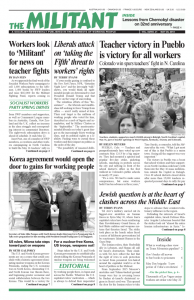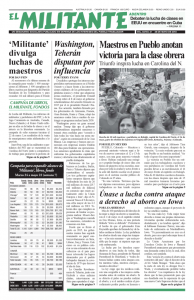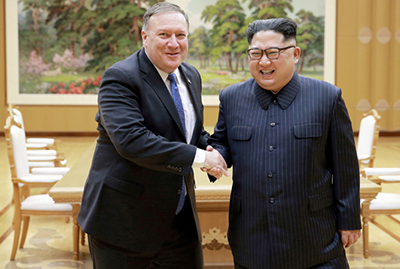The U.S. and North Korean governments are on a course that could conclude with a historic agreement eliminating nuclear weapons on the Korean Peninsula, ending the U.S. economic war on North Korea, eliminating U.S. and North Korean war threats there, and beginning greater economic and social collaboration between the two Koreas. This would be a victory for all working people.
A summit meeting between North Korean leader Kim Jong Un and President Donald Trump is now set for June 12 in Singapore. Plans for a summit were first announced in early March. Since then Kim has traveled twice to Beijing to discuss the talks with Chinese President Xi Jinping, met with South Korean President Moon Jae-in April 27, and then met with U.S. Secretary of State Mike Pompeo May 9.
By joining in harsh U.S. and U.N. sanctions, China’s rulers have forced the closing of factories and layoffs of thousands of workers in North Korea over the last year. Some 90 percent of North Korea’s trade is with China.
Kim flew to Dalian, China, for meetings with Xi May 7-8. Xi informed Trump afterwards that Kim favored steps leading to denuclearization.
In early May the government of the Democratic People’s Republic of Korea informed the U.N. that the Central Committee of the ruling Workers’ Party had decided it would no longer conduct intercontinental ballistic missile launches.
The New York Times reported that President Trump requested the Pentagon provide him options for reducing the number of U.S. troops in South Korea, a report that has not been confirmed.
When Pompeo flew to Pyongyang and met with Kim, the Pyongyang Times reported he was “warmly greeted.” Later that day the North Korean government pardoned three U.S. citizens it had been holding prisoner on charges of engaging in hostile activity. The three left North Korea with Pompeo.
Trump personally greeted their plane when it arrived at Joint Base Andrews in Maryland. Thanking Kim, Trump said, “I really think we have a very good chance of doing something very meaningful.”
Then on May 12 — two days after President Trump announced the date and place of the summit — Pyongyang invited journalists from the U.S., South Korea, China, Russia and Britain to come watch as they permanently dismantle the North’s nuclear testing site May 23–25.
Collaboration between two Koreas
An agreement between Washington and Pyongyang would benefit working people in North Korea, who have born the brunt of the punishing U.S.-U.N. sanctions.
According to press reports, when North Korean leader Kim met with South Korean President Moon in late April, Moon said he would like to visit Baekdu Mountain. Kim replied that he would be embarrassed to have Moon travel through North Korea because “our transportation, honestly would be uncomfortable.” He was referring to the North’s antiquated and deteriorated railway system.
Moon gave Kim a blueprint for modernizing and building rail lines from Seoul to Pyongyang and ultimately to the Chinese border, where it could connect with Russia’s Trans-Siberian Railroad. The estimated $35 billion price tag would be paid for by capitalist investors in South Korea and China.
This would give Beijing an overland connection to South Korea, already an important trading partner. It would help the working class in North Korea break out of their isolation, opening the door to greater economic development, as well as give a boost to the Korean people’s longstanding desire for reunification.
Long history of resistance in Korea
The government of North Korea has stated before that it would end its nuclear weapons program if the U.S. government would sign a peace treaty to formally end the 1950-53 Korean War and pledge not to attack in the future. More than 4 million people died in that war, including at least 2 million civilians, hundreds of thousands of Chinese and tens of thousands of U.S. soldiers.
The war was a result of Washington’s division of Korea into North and South, carried out with the collusion of Moscow, at the end of World War II. It was imposed against the will of the Korean people, who had resisted Japanese imperialism’s decadeslong occupation of the peninsula. Instead of gaining independence they found themselves facing a U.S.-installed dictatorship in the South.
U.S.-led invasion forces bombed and napalmed the North to the ground and made it almost to the border with China before they were pushed back. With the aid of Chinese volunteers, the Korean fighters fought the U.S.-led forces to a stalemate at the 38th parallel, dealing U.S. imperialism its first ever defeat. While the U.S. government agreed to an armistice in 1953, it has refused to sign a peace treaty and still has 28,500 troops in the South today.
Supporters of the North’s nuclear program argued that the DPRK needed nuclear weapons as a deterrent to another U.S. attack. But having nuclear weapons and threatening to send a “rain of fire” against South Korea and others if attacked, undercuts the moral authority the Korean people had won in the course of the war.
After months of accusing the president of being a warmonger, a racist and a loose cannon, some “never-Trumpers” of both the Democratic and Republican parties are discombobulated over the upcoming negotiations.
In a column in the April 25 New York Times, Nicholas Eberstadt, from the Committee for Human Rights in North Korea, calls the idea of a permanent peace in Korea “delusional” and warns that Kim Jong Un is going to bamboozle Trump.
While much of the discussion of the talks in the media focuses on denuclearization, the talks include the massive array of North Korea’s conventional missiles aimed at the South, along with Washington’s formidable weaponry aimed at the North.
Denuclearization has special meaning for working people in Japan, who vividly recall the horror of the U.S. rulers’ nuclear attacks on Hiroshima and Nagasaki in 1945.
The U.S. ruling class backs Trump’s North Korea talks. His goal is to be known as a “peace” president. Even the New York Times grudgingly recognized this fact May 9, in an article headlined, “President Trump a Nobel Laureate? It’s a Possibility.”


